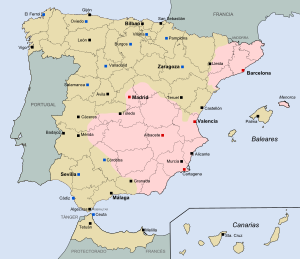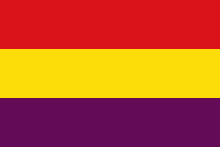|
Central Region Army Group
 The Central Region Army Group, Spanish: Grupo de Ejércitos de la Región Central (GERC), was a military formation of the Spanish Republican Army during the last phase of the Spanish Civil War. It gathered the most powerful section of the republican military and would endure until the 1939 surrender. The GERC was under the command of general José Miaja Menant, the Defence of Madrid hero. HistoryThe Central Region Army Group was established on 16 April 1938 by means of an order of the general Staff of the Popular Republican Army. It sought to reorganize the Republican forces following the disastrous campaigns of the Aragon Offensive and the splitting of the Spanish Republican territory in two by the rebel faction. It was initially named "Group of Armies of the Central-Southern Zone" (Agrupación de Ejércitos de la Zona Centro-Sur) before being renamed as Central Region Army Group.[1] At the time of its establishment it was composed by four armies:
In total 16 Army corps, 49 divisions and 138 mixed brigades.[2] It also included a Coastal Defence brigade and the two anti-aircraft artillery brigades of the Defensa Contra Aeronaves (DCA).[3] In June the same year, the Eastern Region Army Group Grupo de Ejércitos de la Región Oriental (GERO) would be established as well. In December 1938 the GERC was scheduled to take part in General Vicente Rojo Lluch's "Plan P", an ambitious project of an offensive campaign in Extremadura that would have taken place at the same time as a disembarkment within the enemy lines in Motril, along with diversionary attacks in other places of Andalusia and the Madrid Front. However, in the face of the opposition of General Miaja and other Republican commanders to the implementation of the whole plan, it was not carried out to its full extent and the only action taken was the Battle of Valsequillo which resulted in failure shortly before having been initiated.[4] Following the fall of Catalonia in February, on 2 March 1939 President Juan Negrín arranged for a reorganization of the Republican Armed Forces in the Central Zone, decreeing the disbandment of the GERC, as well as a reorganization of the command structure.[5] However, Segismundo Casado's coup that took place a few days later would hinder the implementation of these eleventh-hour measures. Structure
See also
References
Bibliography
|
||||||||||||||||||||||||||||||||||||||||||||||||||||||||||||||||||||||||||||||||||||||||||
Portal di Ensiklopedia Dunia
